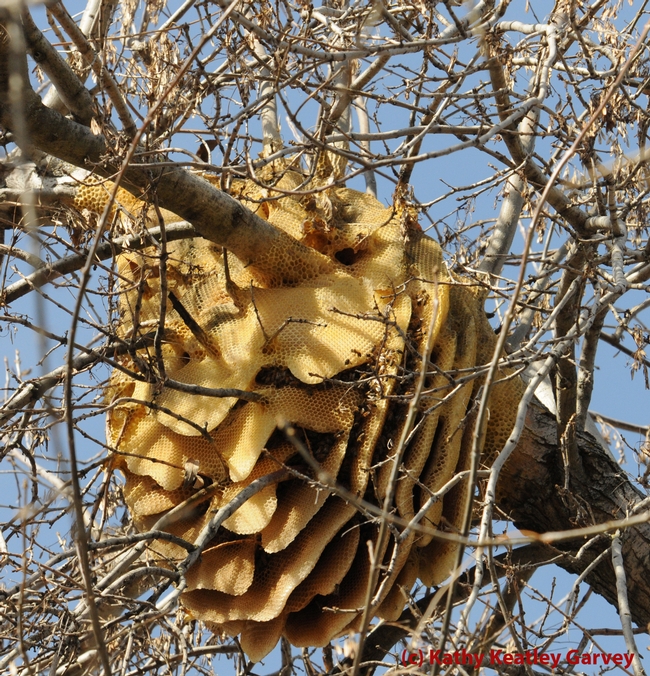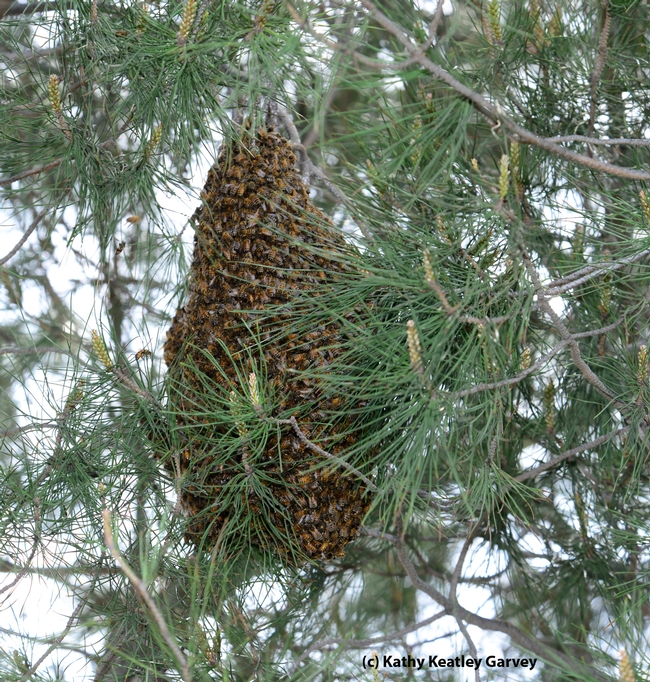
Hollywood movie refer to them as "killer bees." Ditto, the news media.
"The known natural distribution of Africanized honey bees (AHB) in California is along a line that runs diagonally from northeastern Tulare County to southwestern San Luis Obispo County, then south to Mexico," says Extension apiculturist Eric Mussen of the UC Davis Department of Entomology. "A colony of AHB was found in Madera County following almond pollination, and the agricultural commissioner decided to call the county colonized instead of participating in a delimiting survey. However, beekeepers in Fresno County are just beginning to report encountering a few more considerably defensive colonies than they used to."
"In southern California, where AHB has been since 1994, they have pretty well filled the basin," Mussen reports. "The last time tests on feral (not human-kept) honey bee colonies and swarms were conducted, AHB were determined to be a little over 80 percent of the totals. That still may be the case with feral bees in that area, although one would expect a bit lessening of defensive behavior over time, as has happened in Brazil."
But, as Mussen points out, "it took 40 years to reach the point that AHB are not too problematic in Brazil. We have had them in California only 18 years."
“There’s no way to tell if honey bees are Africanized without DNA testing,” says Mussen, who writes from the UC Apiaries and Bee Briefs on the UC Davis Department of Entomology website. “They look about the same as the European honey bee. They tend to be a little darker than European honey bees and a little smaller. What sets them apart is their intensive defensive behavior. They’ve been known to chase their victims a quarter of a mile.”
When beekeepers find intensive defensive behavior in their hives, they kill the queen bee and “requeen” the colony. “Over four to six weeks, the original workers die of old age and the new queen replaces them with more daughters,” Mussen said.
Africanized honey bees are the result of attempts to hybridize European honey bees (Apis mellifera) with an African race. Researchers brought Tanzanian queen bees (Apis mellifera scutella) to Brazil in the 1950s. In 1957, some of the African bee descendants escaped from the researchers and beekeepers and began progressing north.
The descendants reached southern Texas in 1990 and southern California in 1994. “In California, they were first found “just outside of Blythe, in Riverside County,” Mussen recalls.
“As an area becomes colonized, the Africanized bees will show their true colors—they will exhibit their intense defensive behavior,” says Mussen, an Extension apiculturist since 1976,
Mussen recommends that anyone working or relaxing in areas known to be colonized by
Africanized bees “take precautions” by avoiding nesting areas. If the bees start to sting, cover your face with a shirt as you run for a building, vehicle or other shelter, he says. You can also carry an Army surplus gnat/mosquito veil with you to protect your face.
The honey bees’ pheromone, resembling the scent of a banana, sounds the alarm, alerting other bees to attack.
Beekeepers who collect swarms in colonized counties have a “high probability” of hiving an Africanized honey bee colony, Mussen points out, and should always look for unacceptable defensive behavior.
His advice: "It still is not a good idea to collect swarms in southern California and hive them in high human population areas."
“Africanized honey bees are not something to be feared,” Mussen said, “but they are to be respected.”
(Note: Click on this USDA map to see where the Africanized bees are now.)
Attached Images:

